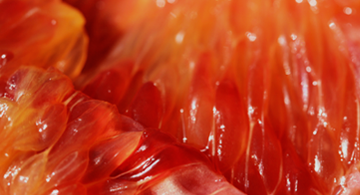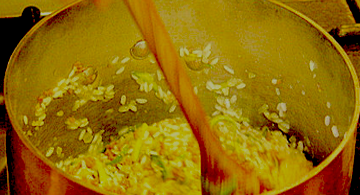
Let's spice it up. After the holiday with family and friends, we love sharing our table and familiar dishes, yet we crave something different to eat. Family culinary traditions are powerful expressions uniting the generations. Sometimes melding cultures and cuisines in a dish is just what the family needs, bringing pleasing new discoveries.
Pasta with tomato sauce satisfies the familiar. So what surprises us? Transform roast turkey leftovers into the most delectable Roast Turkey Ragù, flavored with 'Nduja, the spicy pork and chili pepper salume. Originating in the small town of Spilinga in southern Calabria, its popularity is spreading and excellent variations of ‘Nduja made in the USA and other countries are readily available. Learn more about ‘Nduja
No doubt, there is a lot of turkey remaining after the festivities, so include breast, thigh, and leg for this dish. Since cooked turkey is already tender, coarsely chop it or cut into neat 1/2-inch (1.3-cm) cubes because it cannot be cooked long without falling apart. Make a real ragù beginning with a savory soffritto of onion, celery, and crumbled sausage. With really good chicken or pork sausages available at our local grocery stores, any fresh or smoked sausage will do for the soffritto, whether it is mild and sweet, or loaded with garlic and chili peppers.
Often considered the Italian cousin of French andouille sausage, ‘Nduja adds a complex peppery, smoky base. Near the end of cooking the soffritto, stir in soft, spreadable ‘Nduja, adding a dab to tickle the taste buds or spoonfuls launching it onto the chart of Scoville heat units! If it is unavailable, be sure to add an assertive chorizo, andouille, or hot Calabrian sausage. Then stir in the turkey and the tomatoes, season and simmer until thickened.
This quick ragù completes in under an hour, perfect for after-holiday meals. Leftovers are put to great use. Adjust quantities to include ingredients you have on-hand. For your convenience, make it in advance and store in the refrigerator up to two days. When serving, a topping of creamy ricotta soothes the heat, adding a rich, luscious note to the pasta dish.
Not only is Roast Turkey Ragù foolproof, it combines the familiar with the unexpected for your holiday table. Cooking together can be a joyous affair, so cook your heart out, share jokes and laugh along the way. Peak everyone’s curiosity by spreading the love of ‘Nduja. Then grab a fork and tuck in…
Cooking Time is about 50 minutes. Makes 4 cups (946 ml) ragù.
4 to 6 servings
Roast Turkey Ragù:
3 tablespoons (44 ml) extra-virgin olive oil
1/4 small yellow onion, finely chopped
1 medium celery stalk, finely chopped
2 links (8 ounces or 230 g) chicken or pork sausage, casing removed, crumbled
1 to 2 tablespoons (0.5 to 1 ounce or 14 to 28 g) ‘Nduja or to taste
2 cups chopped roast turkey (boneless, skinless, roasted, 10 ounces or 285 g)
1 28-ounce (794 g) can whole peeled plum tomatoes, coarsely chopped with their juice
Dried oregano to taste
Salt to taste – near the end of cooking because roast turkey was previously seasoned
Recommended Pasta: 1 pound (or 454 gm) mezze penne, penne, farro penne, maccheroncini.
Recommended Cheese Topping: Freshly grated aged Pecorino, Caciocavallo, or Parmigiano-Reggiano cheese.
Fresh ricotta garnish.
1. The soffritto takes about 20 minutes. Pour oil into a non-stick Dutch oven or deep pot. Over low heat, saute the onion and celery until beginning to soften, 4 to 5 minutes. Add the crumbled sausage and saute for about 8 minutes, without browning edges. Stir the ‘Nduja into the soffritto for a few seconds until it smooths out and its fragrance rises and envelopes you. Watch closely and do not brown it. Add the roast turkey, stir and saute until completely hot to the touch, about 5 minutes.
2. Cooking time is 25 minutes. Increase the heat to high. Add the chopped tomatoes with their juice, dried oregano to taste, and bring to a boil. Decrease the heat to low. Leaving the pot uncovered, simmer until the tomatoes reduce and thicken a little, about 20 minutes. During this time, stir a few times without breaking apart the turkey. Taste and season to taste with salt. *Stop at this point if you want to. Cover and allow to rest up to 1 hour. Set-up the dining area, have the serving bowls ready for plating. Mix the fresh ricotta with some aged grated cheese and reserve.
3. Boiling the Pasta: In a deep pot, bring lightly salted water to a rolling boil. Add the pasta, stirring occasionally to prevent the pasta from sticking together. While the pasta is boiling, scoop out 1 cup (or 237 ml) cooking water and reserve. Boil the pasta until firm al dente, because it continues to cook when combined with the ragù.
Serving the Ragù: When the pasta is almost finished boiling, warm the ragù over low heat for 2 to 3 minutes. Increase the heat to high. Drain the pasta leaving a little water clinging to it, and immediately add to the simmering ragù. Toss the pasta with the ragù. Add some reserved cooking water as needed to moisten the pasta and ragù. Do not add the full cup unless necessary. When the ragù lightly coats the pasta making it glisten, after cooking for 2 to 3 minutes, plate. Lightly sprinkle some aged grated cheese over, then add a dollop of fresh ricotta on top and serve immediately. Enjoy!
'Nduja Note: What staples do you keep in your kitchen? Ketchup, mustard, soy sauce, mayo? Perhaps a bottle of sriracha? Add 'Nduja to your list. I keep some in my fridge. Always. Not only does it make a great crostini snack slathered on grilled bread, it is a super ingredient. Do you make your own pizza or have it delivered? Next time, place some dollops of this spicy salame on top. You'll love it. It's great on focaccia and other flatbreads, too. Stir it into soups, all kinds of sauces, and curries. Stir-fry poultry, meat, seafood, seitan, and tempeh with it, even vegetables benefit from its kick.
Having tasted and cooked with several brands, I love trying variations of 'Nduja. Chef Evan Brady is passionate about 'Nduja. So passionate in fact, that he is Responsabile Produzione for 'Nduja Artisans Salumeria, located in Chicago, Illinois. Established by Agostino Fiasche and his son Antonio, their products are exemplary examples of their heritage and five generations of Calabrian salumi makers. Products are made with 100% Berkshire Natural Pork. Berkshire hogs are raised on family farms in the Midwest, USA. With a vegetarian-based diet, they are never given antibiotics, growth promotants, or hormones. This breed is prized for its characteristic marbling which gives it tenderness, moisture, and deep flavor.
From Evan: "Our ‘Nduja is made with heritage Berkshire pork, and imported peppers. We do not use any nitrates or nitrites in our ’Nduja or any preservatives. It consists of a simple recipe; pork, sea salt, and peppers. We utilize a slow, natural fermentation process, which in turn leads to more flavor in the final product. Our small format ‘Nduja is aged for at least a month, and our ‘Nduja in “Orba” (a traditional hog casing native to the Calabrian region) is aged for a minimum of 4 months. The best part of this product is its versatility in the kitchen. While it is amazing on grilled bread it pairs perfectly with seafood and roasted meats. We recommend you view ‘Nduja more as an ingredient, than solely a salami for a charcuterie board."
"While the product is shelf stable at room temperatures, unopened, we still recommend you store it under refrigeration until you are ready to serve. If stored this way we suggest a 1-year shelf life. For the best ‘Nduja experience, we recommend you temper the ‘Nduja back to room temperature before eating. Once opened, if re-packed nicely, it will last a month under refrigeration, and if vacuum sealed after each use we suggest 3 months."







